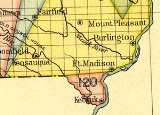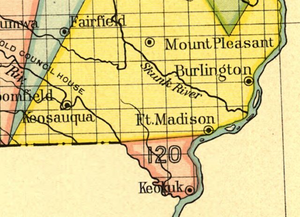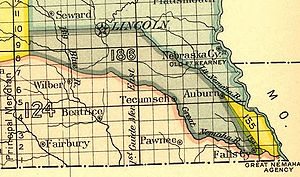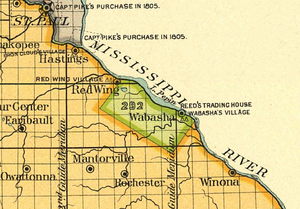
Half-Breed Tract
Encyclopedia
A Half-Breed Tract was a segment of land designated in the western states by the United States government in the 19th century specifically for people of American Indian
and European
or European-American ancestry, known as mixed bloods. The government set aside such tracts in several U.S. states, including Iowa
, Nebraska
, Kansas
, Minnesota
, and Wisconsin
.
people were the descendants of marriages or relationships between American Indian
and white Europeans
or European Americans. Also known as "half-breeds" in the U.S. or métis in Canada, these people were often descended from American Indian women and French-Canadian, Scots, and Orkney Island fathers, who dominated early fur trapping and trade. The men lived far from other Europeans. Others had fathers who were American trappers and traders.
Because of rules about membership and clans among Indian tribes, and European classification of the children as being more Indian than white (combined with the idea that the fathers were "outside" civilized society as mountain men), the children often were excluded from benefiting both from the laws governing Indians and the political rights of their fathers. Omaha
and other tribal leaders advocated setting land aside for the mixed-blood descendants; usually the intent was to award land to male heads of families.
The relationship between mixed-bloods and their ancestral tribes particularly affected the descendants when the tribes ceded communal lands to the U.S. government in exchange for payment. The rights of mixed-blood descendants to payments or a part in decisionmaking were not usually acknowledged. In 1830 the federal government acknowledged this problem by the Treaty of Prairie du Chien
, which effectively set aside a tract of land for mixed-blood people related to the Oto
, Ioway, Omaha
, Sac and Fox and Santee Sioux tribes. The treaty granted these "Half-Breed Tracts" as sections of land in a form similar to Indian reservation
s.
 A Half-Breed Tract was located in Lee County, Iowa
A Half-Breed Tract was located in Lee County, Iowa
, roughly near 41.52°N 97.47°W. An 1824 treaty between the Sacs
, Foxes and the United States set aside a reservation for mixed-blood people related to the tribes. The land contained approximately 119000 acres (481.6 km²) lying between the Mississippi
and Des Moines River
s. Under the original treaty, the half-breed people had the right to occupy the soil, but individuals could not buy or sell it.
In 1834 Congress repealed the rule. Immediately afterward, claim jumpers claimed much of the land. The government gave away mixed-blood peoples' claims to the land, effectively ending this Half-Breed Tract by 1841.
The Mormon Joseph Smith, Jr. purchased parts of the Half-Breed Tract, probably in 1837, from a land speculation company. Deeds to most of the land were faulty and could not be held. This left the church with only about 1000 acres (4 km²), including a town called Commerce in Illinois
. The Mormons moved to this Illinois site from Far West, Missouri
, to escape the Mormon extermination order by Missouri Governor Lilburn Boggs
.
 The Nemaha Half-Breed Reservation was established on July 15, 1830. The tract's eastern border was the Missouri River, and the property extended inland for 10 miles (16.1 km). The north/south borders were between the Little Nemaha River to the north and the Great Nemaha River, near Falls City
The Nemaha Half-Breed Reservation was established on July 15, 1830. The tract's eastern border was the Missouri River, and the property extended inland for 10 miles (16.1 km). The north/south borders were between the Little Nemaha River to the north and the Great Nemaha River, near Falls City
to the south. Owners were never required to live on their property and many eventually sold their lands to whites. Nebraska's Half-Breed Tract vanished as a legal entity by 1861.
from present day Topeka
to Williamstown
. The purpose of granting the land to the mixed-bloods was to gain their support for the treaty in which the Kaw ceded a large amount of land to the United States in exchange for annuities. Indian Superintendent William Clark said, "Reserves of this kind...have a good effect in promoting civilization...an idea of separate property is imparted without which it is vain to think of improving the minds and morals of the Indian."
Several of the Kaw half-breed tracts were to become important sites in Kansas history. In 1827 the Kaw Agency was founded on Tract number 23, allotted to Joseph James, Jr.
. Here lived the Government Agent to the Kaw, the government farmer, Daniel M. Boone, son of the famous pioneer, Daniel Boone
, a blacksmith, several mixed blood Kaw and French traders, and White Plume
, recognized by the U.S. government as the head chief of the Kaw. Tract number three, located on the site of Topeka, was to become the site of the Pappan Ferry in the 1840s, a crossing of the Kansas River utilized by pioneers heading west on the Oregon Trail
. Tract four was allotted to Julie Gonville, the maternal grandmother of Charles Curtis
, later to become Vice President of the United States.
A similar treaty was also signed in 1825 between the Osage
Indians and the United States. The Osage ceded lands in Missouri, Arkansas, and south of the Arkansas River
in Oklahoma
in exchange for a reservation in Kansas and Oklahoma. Forty-two tracts of one-square mile each were reserved for the mixed blood children of French traders and Osage women. Most of the tracts were scattered around eastern Kansas but a few were on the Neosho River
in Oklahoma.
 The 1830 Treaty of Prairie du Chien specified the following boundaries of a Half-Breed Tract centered around Lake Pepin
The 1830 Treaty of Prairie du Chien specified the following boundaries of a Half-Breed Tract centered around Lake Pepin
, as follows:
This description includes a large part of what is now Wabasha County, Minnesota
, and some part of Goodhue County, Minnesota
. Despite the petitions of several "half-breed" landowners, who had by then lived there for more than twelve years, the US government took the land in 1852 under the premise of serving as restitution against the Sioux for having violated the terms of an earlier treaty. The land reclamation followed explorers' identification of the area as a "mineral region" with the prospect that, "lead will be found there, and probably copper also."
Native Americans in the United States
Native Americans in the United States are the indigenous peoples in North America within the boundaries of the present-day continental United States, parts of Alaska, and the island state of Hawaii. They are composed of numerous, distinct tribes, states, and ethnic groups, many of which survive as...
and European
European ethnic groups
The ethnic groups in Europe are the various ethnic groups that reside in the nations of Europe. European ethnology is the field of anthropology focusing on Europe....
or European-American ancestry, known as mixed bloods. The government set aside such tracts in several U.S. states, including Iowa
Iowa
Iowa is a state located in the Midwestern United States, an area often referred to as the "American Heartland". It derives its name from the Ioway people, one of the many American Indian tribes that occupied the state at the time of European exploration. Iowa was a part of the French colony of New...
, Nebraska
Nebraska
Nebraska is a state on the Great Plains of the Midwestern United States. The state's capital is Lincoln and its largest city is Omaha, on the Missouri River....
, Kansas
Kansas
Kansas is a US state located in the Midwestern United States. It is named after the Kansas River which flows through it, which in turn was named after the Kansa Native American tribe, which inhabited the area. The tribe's name is often said to mean "people of the wind" or "people of the south...
, Minnesota
Minnesota
Minnesota is a U.S. state located in the Midwestern United States. The twelfth largest state of the U.S., it is the twenty-first most populous, with 5.3 million residents. Minnesota was carved out of the eastern half of the Minnesota Territory and admitted to the Union as the thirty-second state...
, and Wisconsin
Wisconsin
Wisconsin is a U.S. state located in the north-central United States and is part of the Midwest. It is bordered by Minnesota to the west, Iowa to the southwest, Illinois to the south, Lake Michigan to the east, Michigan to the northeast, and Lake Superior to the north. Wisconsin's capital is...
.
Overview
In this context, mixed-bloodMixed-blood
The term mixed-blood in the United States is most often employed for individuals of mixed European and Native American ancestry who are not of Hispanic descent . Some of the most prominent in the 19th century were mixed-blood or mixed-race children born of marriages and unions between fur traders...
people were the descendants of marriages or relationships between American Indian
Native Americans in the United States
Native Americans in the United States are the indigenous peoples in North America within the boundaries of the present-day continental United States, parts of Alaska, and the island state of Hawaii. They are composed of numerous, distinct tribes, states, and ethnic groups, many of which survive as...
and white Europeans
White people
White people is a term which usually refers to human beings characterized, at least in part, by the light pigmentation of their skin...
or European Americans. Also known as "half-breeds" in the U.S. or métis in Canada, these people were often descended from American Indian women and French-Canadian, Scots, and Orkney Island fathers, who dominated early fur trapping and trade. The men lived far from other Europeans. Others had fathers who were American trappers and traders.
Because of rules about membership and clans among Indian tribes, and European classification of the children as being more Indian than white (combined with the idea that the fathers were "outside" civilized society as mountain men), the children often were excluded from benefiting both from the laws governing Indians and the political rights of their fathers. Omaha
Omaha
Omaha may refer to:*Omaha , a Native American tribe that currently resides in the northeastern part of the U.S. state of Nebraska-Places:United States* Omaha, Nebraska* Omaha, Arkansas* Omaha, Georgia* Omaha, Illinois* Omaha, Texas...
and other tribal leaders advocated setting land aside for the mixed-blood descendants; usually the intent was to award land to male heads of families.
The relationship between mixed-bloods and their ancestral tribes particularly affected the descendants when the tribes ceded communal lands to the U.S. government in exchange for payment. The rights of mixed-blood descendants to payments or a part in decisionmaking were not usually acknowledged. In 1830 the federal government acknowledged this problem by the Treaty of Prairie du Chien
Treaty of Prairie du Chien
The Treaty of Prairie du Chien may refer to any of several treaties made and signed in Prairie du Chien, Wisconsin between the United States, representatives from the Sioux, Sac and Fox, Menominee, Ioway, Winnebago and the Anishinaabeg Native American peoples.-1825:The first treaty of Prairie du...
, which effectively set aside a tract of land for mixed-blood people related to the Oto
Otoe tribe
The Otoe or Oto are a Native American people. The Otoe language, Chiwere, is part of the Siouan family and closely related to that of the related Iowa and Missouri tribes.-History:...
, Ioway, Omaha
Omaha (tribe)
The Omaha are a federally recognized Native American nation which lives on the Omaha Reservation in northeastern Nebraska and western Iowa, United States...
, Sac and Fox and Santee Sioux tribes. The treaty granted these "Half-Breed Tracts" as sections of land in a form similar to Indian reservation
Indian reservation
An American Indian reservation is an area of land managed by a Native American tribe under the United States Department of the Interior's Bureau of Indian Affairs...
s.
Iowa

Lee County, Iowa
-2010 census:The 2010 census recorded a population of 35,862 in the county, with a population density of . There were 16,205 housing units, of which 14,610 were occupied.-2000 census:...
, roughly near 41.52°N 97.47°W. An 1824 treaty between the Sacs
Sac (tribe)
The Sacs or Sauks are a group of Native Americans of the Eastern Woodlands culture group. Their autonym is The Sacs or Sauks are a group of Native Americans of the Eastern Woodlands culture group. Their autonym is The Sacs or Sauks are a group of Native Americans of the Eastern Woodlands culture...
, Foxes and the United States set aside a reservation for mixed-blood people related to the tribes. The land contained approximately 119000 acres (481.6 km²) lying between the Mississippi
Mississippi River
The Mississippi River is the largest river system in North America. Flowing entirely in the United States, this river rises in western Minnesota and meanders slowly southwards for to the Mississippi River Delta at the Gulf of Mexico. With its many tributaries, the Mississippi's watershed drains...
and Des Moines River
Des Moines River
The Des Moines River is a tributary river of the Mississippi River, approximately long to its farther headwaters, in the upper Midwestern United States...
s. Under the original treaty, the half-breed people had the right to occupy the soil, but individuals could not buy or sell it.
In 1834 Congress repealed the rule. Immediately afterward, claim jumpers claimed much of the land. The government gave away mixed-blood peoples' claims to the land, effectively ending this Half-Breed Tract by 1841.
The Mormon Joseph Smith, Jr. purchased parts of the Half-Breed Tract, probably in 1837, from a land speculation company. Deeds to most of the land were faulty and could not be held. This left the church with only about 1000 acres (4 km²), including a town called Commerce in Illinois
Illinois
Illinois is the fifth-most populous state of the United States of America, and is often noted for being a microcosm of the entire country. With Chicago in the northeast, small industrial cities and great agricultural productivity in central and northern Illinois, and natural resources like coal,...
. The Mormons moved to this Illinois site from Far West, Missouri
Far West, Missouri
Far West, Missouri, was a Latter Day Saint settlement in Caldwell County, Missouri.-Foundation and early history:The town was founded by Missouri Mormon leaders, W. W. Phelps and John Whitmer in August 1836 shortly before the county's creation. The town was platted originally as a square area,...
, to escape the Mormon extermination order by Missouri Governor Lilburn Boggs
Lilburn Boggs
Lilburn Williams Boggs was the sixth Governor of Missouri from 1836 to 1840. He is now most widely remembered for his interactions with Joseph Smith and Porter Rockwell, and Missouri Executive Order 44, known by Mormons as the "Extermination Order", issued in response to the ongoing conflict...
.
Nebraska

Falls City, Nebraska
Falls City is a city in Richardson County, Nebraska, United States. The population was 4,671 at the 2000 census. It is the county seat of Richardson County.-Geography:Falls City is located at ....
to the south. Owners were never required to live on their property and many eventually sold their lands to whites. Nebraska's Half-Breed Tract vanished as a legal entity by 1861.
Kansas
An 1825 treaty with the Kaw Indians reserved land of one square mile (640 acres) for each of twenty-three Kaw mixed bloods. The tracts were located on the north bank of the Kansas RiverKansas River
The Kansas River is a river in northeastern Kansas in the United States. It is the southwestern-most part of the Missouri River drainage, which is in turn the northwestern-most portion of the extensive Mississippi River drainage. Its name come from the Kanza people who once inhabited the area...
from present day Topeka
Topeka, Kansas
Topeka |Kansa]]: Tó Pee Kuh) is the capital city of the U.S. state of Kansas and the county seat of Shawnee County. It is situated along the Kansas River in the central part of Shawnee County, located in northeast Kansas, in the Central United States. As of the 2010 census, the city population was...
to Williamstown
Williamstown, Kansas
Williamstown is an unincorporated community in southeastern Jefferson County, Kansas, United States, off U.S. Route 24....
. The purpose of granting the land to the mixed-bloods was to gain their support for the treaty in which the Kaw ceded a large amount of land to the United States in exchange for annuities. Indian Superintendent William Clark said, "Reserves of this kind...have a good effect in promoting civilization...an idea of separate property is imparted without which it is vain to think of improving the minds and morals of the Indian."
Several of the Kaw half-breed tracts were to become important sites in Kansas history. In 1827 the Kaw Agency was founded on Tract number 23, allotted to Joseph James, Jr.
Joseph James and Joseph James, Jr.
Joseph James is the name of two Kaw/Osage/French interpreters on the Kansas and Oklahoma frontier in the nineteenth century. Both were usually called “Joe Jim” or “Jojim.”-Joe Jim:...
. Here lived the Government Agent to the Kaw, the government farmer, Daniel M. Boone, son of the famous pioneer, Daniel Boone
Daniel Boone
Daniel Boone was an American pioneer, explorer, and frontiersman whose frontier exploits mad']'e him one of the first folk heroes of the United States. Boone is most famous for his exploration and settlement of what is now the Commonwealth of Kentucky, which was then beyond the western borders of...
, a blacksmith, several mixed blood Kaw and French traders, and White Plume
White Plume
White Plume , also known as Nom-pa-wa-rah, Manshenscaw, and Monchousia, was a chief of the Kaw Indians. He signed a treaty in 1825 ceding millions of acres of Kaw land to the United States. Most present-day members of the Kaw Nation of Oklahoma trace their lineage back to him...
, recognized by the U.S. government as the head chief of the Kaw. Tract number three, located on the site of Topeka, was to become the site of the Pappan Ferry in the 1840s, a crossing of the Kansas River utilized by pioneers heading west on the Oregon Trail
Oregon Trail
The Oregon Trail is a historic east-west wagon route that connected the Missouri River to valleys in Oregon and locations in between.After 1840 steam-powered riverboats and steamboats traversing up and down the Ohio, Mississippi and Missouri rivers sped settlement and development in the flat...
. Tract four was allotted to Julie Gonville, the maternal grandmother of Charles Curtis
Charles Curtis
Charles Curtis was a United States Representative, a longtime United States Senator from Kansas later chosen as Senate Majority Leader by his Republican colleagues, and the 31st Vice President of the United States...
, later to become Vice President of the United States.
A similar treaty was also signed in 1825 between the Osage
Osage Nation
The Osage Nation is a Native American Siouan-language tribe in the United States that originated in the Ohio River valley in present-day Kentucky. After years of war with invading Iroquois, the Osage migrated west of the Mississippi River to their historic lands in present-day Arkansas, Missouri,...
Indians and the United States. The Osage ceded lands in Missouri, Arkansas, and south of the Arkansas River
Arkansas River
The Arkansas River is a major tributary of the Mississippi River. The Arkansas generally flows to the east and southeast as it traverses the U.S. states of Colorado, Kansas, Oklahoma, and Arkansas. The river's initial basin starts in the Western United States in Colorado, specifically the Arkansas...
in Oklahoma
Oklahoma
Oklahoma is a state located in the South Central region of the United States of America. With an estimated 3,751,351 residents as of the 2010 census and a land area of 68,667 square miles , Oklahoma is the 28th most populous and 20th-largest state...
in exchange for a reservation in Kansas and Oklahoma. Forty-two tracts of one-square mile each were reserved for the mixed blood children of French traders and Osage women. Most of the tracts were scattered around eastern Kansas but a few were on the Neosho River
Neosho River
The Neosho River is a tributary of the Arkansas River in eastern Kansas and northeastern Oklahoma in the United States. Its tributaries also drain portions of Missouri and Arkansas. The river is about long. Via the Arkansas, it is part of the Mississippi River watershed.- Course :The Neosho's...
in Oklahoma.
Minnesota and Wisconsin

Lake Pepin
Lake Pepin is a naturally occurring lake, and the widest naturally occurring part of the Mississippi River, located approximately 60 miles downstream from Saint Paul, Minnesota. It is a widening of the river on the border between Minnesota and Wisconsin. The formation of the lake was caused by the...
, as follows:
"The Sioux bands in council have earnestly solicited that they might have permission to bestow upon the half-breeds of their nation the tract of land within the following limits, to wit: Beginning at the place called the BarnBarn Bluff (Red Wing, Minnesota)Barn Bluff is a bluff along the Mississippi River in Red Wing, Minnesota. The bluff is associated with Dakota legend from hundreds of years ago. During the 19th century, the bluff functioned as a visual reference for explorers and travelers. The bluff overlooks the downtown area and towers about...
, below and near the village of the Red Wing chiefRed Wing, MinnesotaRed Wing is a city in Goodhue County, Minnesota, United States, on the Mississippi River. The population was 16,459 at the 2010 census. It is the county seat of Goodhue County....
, and running back fifteen miles; thence, in a parallel line with Lake PepinLake PepinLake Pepin is a naturally occurring lake, and the widest naturally occurring part of the Mississippi River, located approximately 60 miles downstream from Saint Paul, Minnesota. It is a widening of the river on the border between Minnesota and Wisconsin. The formation of the lake was caused by the...
and the MississippiMississippi RiverThe Mississippi River is the largest river system in North America. Flowing entirely in the United States, this river rises in western Minnesota and meanders slowly southwards for to the Mississippi River Delta at the Gulf of Mexico. With its many tributaries, the Mississippi's watershed drains...
, about 32 miles, to a point opposite the river aforesaid; the United States agree to suffer said half-breeds to occupy said tract of country; they holding by the same title, and in the same manner that other Indian titles are held."
This description includes a large part of what is now Wabasha County, Minnesota
Wabasha County, Minnesota
As of the census of 2000, there were 21,610 people, 8,277 households, and 5,876 families residing in the county. The population density was 41 people per square mile . There were 9,066 housing units at an average density of 17 per square mile...
, and some part of Goodhue County, Minnesota
Goodhue County, Minnesota
Goodhue County is a county located in the U.S. state of Minnesota. As of 2010, the population was 46,183. Its county seat is Red Wing. Nearly all of Prairie Island Indian Community is within the county.-History:...
. Despite the petitions of several "half-breed" landowners, who had by then lived there for more than twelve years, the US government took the land in 1852 under the premise of serving as restitution against the Sioux for having violated the terms of an earlier treaty. The land reclamation followed explorers' identification of the area as a "mineral region" with the prospect that, "lead will be found there, and probably copper also."
External links
- Indian Land Cessions: U.S. Congressional Documents
- Barkwell, Lawrence. "Lake Pepin Half-Breed Tract". Louis Riel Institute.

